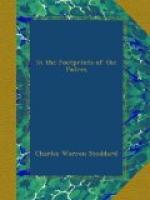Of course there were handsome residences (not so very many of them as yet), where there was fine art—some of the finest. But often this art was to be found in the saloons, and the subjects chosen would hardly find entertainment elsewhere. The furnishing of the houses was within the bounds of good taste. Monumental marbles were not erected by the hearth-side; the window drapery was diaphanous rather than dense and dowdy. The markets of San Francisco were much to blame for the flashiness of the domestic interior: they were stocked with the gaudiest fixtures and textures, and in the inspection of them the eye was bewildered and the taste demoralized.
Harmony survived the inharmonious, and it prevailed in the homes of the better classes, as it was bound to do; for refinement had set its seal there, and you can not counterfeit the seal of refinement. But I am inclined to think that in the Fifties there was a natural tendency to overdress, to over-decorate, to overdo almost everything. Indeed the day was demonstrative; if the now celebrated climate had not yet been elaborately advertised, no doubt there was something hi it singularly bracing. The elixir of it got into the blood and the brain, and perhaps the bones as well. The old felt younger than they did when they left “the States,”—the territory from the Rockies to the Atlantic Ocean was commonly known as “the States.” The middle-aged renewed their youth, and youth was wild with an exuberance of health and hope and happiness that seemed to give promise of immortality.
No wonder that it was thought an honor to be known as the first white child born in San Francisco—I’d think it such myself,—and I’m proud to state that all three claimants are my personal friends.
X.
HAPPY VALLEY
How well I remember it—the Happy Valley of the days of old! It lay between California Street and Rincon Point; was bounded on the east by the Harbor of San Francisco, and on the west by the mission peaks. I never knew just why it was called happy; I never saw any wildly-happy inhabitants singing or dancing for joy on its sometimes rather indefinite street corners. If there is happiness in sand, then, happily, it was sandy. You might have climbed knee-deep up some parts of it and slid down on the other side; you could have played at “hide-and-seek” among its shifting undulations. From what is now known as Nob Hill you could have looked across it to the heights of Rincon Point—and, perchance, have looked in vain for happiness. Yet who or what is happiness? A flying nymph whose airy steps even the sand can not stay for long.
Down through this Happy Valley ran Market Street, a bias cut across the city that was to be. Market Street is about all that saved that city from making a checker-board of its ground-plan. Market Street flew off at a tangent and set all the south portion of the town at an angle that is rather a relief than anything else that I know of. Who wants to go on forever up one street and down another, and then across town at right angles, as if life were a treadmill and there were no hope of change until the great change comes?




